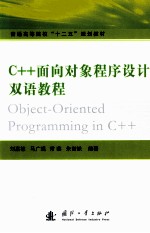

C++面向对象程序设计双语教程PDF电子书下载
- 电子书积分:10 积分如何计算积分?
- 作 者:刘嘉敏,马广焜,常燕,朱世铁编著
- 出 版 社:北京:国防工业出版社
- 出版年份:2013
- ISBN:9787118086034
- 页数:245 页
Chapter 1 Introduction 1
1.1 Overview of Programming 1
1.1.1 What Is Programming? 1
1.1.2 How Do We Write a Program? 3
1.2 The Evolution of Programming Language 5
1.2.1 Assembly and Machine Languages 5
1.2.2 Early Languages 6
1.2.3 Later-Generation Languages 7
1.2.4 Modern Languages 7
1.3 Programming Methodologies 8
1.3.1 Structured Programming 8
1.3.2 Object-Oriented Programming 10
1.4 Object-Oriented Programming 12
1.5 C++Programming Language 15
1.5.1 History of C and C++ 15
1.5.2 Learning C++ 16
Word Tips 17
Exercises 18
Chapter 2 Basic Facilities 19
2.1 C++ Program Structure 19
2.2 Input/Output Streams 21
2.3 Constant 22
2.4 Functions 24
2.4.1 Function Declarations 24
2.4.2 Function Definitions 25
2.4.3 Default Parameters 26
2.4.4 Inline Functions 28
2.4.5 Overloaded Functions 29
2.5 References 33
2.5.1 Reference Definition 33
2.5.2 Reference Variables as Parameters 37
2.5.3 References as Value-Returning 38
2.5.4 References as Left-Hand Values 40
2.6 Namespaces 41
Word Tips 45
Exercises 45
Chapter 3 Classes and Objects(Ⅰ) 49
3.1 Structures 49
3.1.1 Defining a Structure 49
3.1.2 Accessing Members of Structures 50
3.1.3 Structures with Member Functions 52
3.2 Data Abstraction and Classes 53
3.2.1 Data Abstraction 53
3.2.2 Defining Classes 54
3.2.3 Defining Objects 55
3.2.4 Using Member Functions 55
3.2.5 In-Class Member Function Definition 58
3.2.6 File Structure of an Abstract Data Type 59
3.3 Information Hiding 62
3.4 Access Control 63
3.5 Constructors 65
3.5.1 Overloading Constructors 66
3.5.2 Constructors with Default Parameters 67
3.6 Destructors 69
3.6.1 Definition of Destructors 69
3.6.2 Order of Constructor and Destructor Calls 70
Word Tips 73
Exercises 74
Chapter 4 Classes and Objects(Ⅱ) 77
4.1 Constant Members 77
4.2 this Pointers 78
4.3 Static Members 79
4.4 Free Store 84
4.5 Objects as Members of A Class 89
4.6 Copy Members 94
4.6.1 Definition of Copy Constructors 94
4.6.2 Shallow Copy and Deep Copy 97
4.7 Arrays of Objects 106
4.8 Friends 110
4.8.1 Friend Functions 110
4.8.2 Friend Classes 113
4.9 Examples of User-Defined Types 114
Word Tips 120
Exercises 121
Chapter 5 Operator Overloading 125
5.1 Why Operator Overloading Is Need 125
5.2 Operator Functions 126
5.2.1 Overloaded Operators 126
5.2.2 Operator Functions 126
5.3 Binary and Unary Operators 130
5.3.1 Overloading Binary Operators 130
5.3.2 Overloading Unary Operators 131
5.4 Overloading Combinatorial Operators 135
5.5 Mixed Arithmetic of User-Defined Types 139
5.6 Type Conversion of User-Defined Types 139
5.7 Examples of Operator Overloading 141
5.7.1 A Complex Number Class 141
5.7.2 A String Class 149
Word Tips 155
Exercises 156
Chapter 6 Inheritance 158
6.1 Class Hierarchies 158
6.2 Derived Classes 159
6.2.1 Declaration of Derived Classes 159
6.2.2 Structure of Derived Classes 160
6.3 Constructors and Destructors of Derived Classes 163
6.3.1 Constructors of Derived Classes 163
6.3.2 Destructors of Derived Classes 166
6.3.3 Order of Calling Class Objects 167
6.3.4 Inheritance and Composition 170
6.4 Member Functions of Derived Classes 170
6.5 Access Control 173
6.5.1 Access Control in A Class 173
6.5.2 Access to Base Classes 175
6.6 Multiple Inheritance 179
6.6.1 Declaration of Multiple Inheritance 180
6.6.2 Constructors of Multiple Inheritance 182
6.7 Virtual Inheritance 183
6.7.1 Multiple Inheritance Ambiguities 183
6.7.2 Trying to Solve Inheritance Ambiguities 184
6.7.3 Virtual Base C1asses 187
6.7.4 Constructing Objects of Multiple Inheritance 189
Word Tips 191
Exercises 192
Chapter 7 Polymorphism and Virtual Functions 202
7.1 Polymorphism 202
7.1.1 Concept of Polymorphism 202
7.1.2 Binding 203
7.2 Virtual Functions 205
7.2.1 Definition of Vitual Functions 206
7.2.2 Extensibilitv 209
7.2.3 Principle of Virtual Functions 212
7.2.4 Virtual Destructors 213
7.2.5 Function Overloading and Function Overriding 214
7.3 Abstract Base C1asses 217
Word Tips 220
Exercises 220
Chapter 8 Templates 226
8.1 Templates Mechanism 226
8.2 Function Templates and Template Functions 227
8.2.1 Why We Use Function Templates? 227
8.2.2 Definition of Function Templates 228
8.2.3 Function Template Instantiation 229
8.2.4 Function Template with Different Parameter Types 231
8.2.5 Function Template Overloading 232
8.3 Class Templates and Template Classes 233
8.3.1 Definition of Class Templates 233
8.3.2 Class Template Instantiation 236
8.4 Non-Type Parameters for Templates 239
8.5 Derivation and Class Templates 240
Word Tips 242
Exercises 242
References 244
- 《指向核心素养 北京十一学校名师教学设计 英语 七年级 上 配人教版》周志英总主编 2019
- 《设计十六日 国内外美术院校报考攻略》沈海泯著 2018
- 《卓有成效的管理者 中英文双语版》(美)彼得·德鲁克许是祥译;那国毅审校 2019
- 《计算机辅助平面设计》吴轶博主编 2019
- 《高校转型发展系列教材 素描基础与设计》施猛责任编辑;(中国)魏伏一,徐红 2019
- 《景观艺术设计》林春水,马俊 2019
- 《程序逻辑及C语言编程》卢卫中,杨丽芳主编 2019
- 《高等教育双机械基础课程系列教材 高等学校教材 机械设计课程设计手册 第5版》吴宗泽,罗圣国,高志,李威 2018
- 《指向核心素养 北京十一学校名师教学设计 英语 九年级 上 配人教版》周志英总主编 2019
- 《Cinema 4D电商美工与视觉设计案例教程》樊斌 2019
- 《市政工程基础》杨岚编著 2009
- 《家畜百宝 猪、牛、羊、鸡的综合利用》山西省商业厅组织技术处编著 1959
- 《《道德经》200句》崇贤书院编著 2018
- 《高级英语阅读与听说教程》刘秀梅编著 2019
- 《计算机网络与通信基础》谢雨飞,田启川编著 2019
- 《看图自学吉他弹唱教程》陈飞编著 2019
- 《法语词汇认知联想记忆法》刘莲编著 2020
- 《培智学校义务教育实验教科书教师教学用书 生活适应 二年级 上》人民教育出版社,课程教材研究所,特殊教育课程教材研究中心编著 2019
- 《国家社科基金项目申报规范 技巧与案例 第3版 2020》文传浩,夏宇编著 2019
- 《流体力学》张扬军,彭杰,诸葛伟林编著 2019
- 《指向核心素养 北京十一学校名师教学设计 英语 七年级 上 配人教版》周志英总主编 2019
- 《北京生态环境保护》《北京环境保护丛书》编委会编著 2018
- 《指向核心素养 北京十一学校名师教学设计 英语 九年级 上 配人教版》周志英总主编 2019
- 《抗战三部曲 国防诗歌集》蒲风著 1937
- 《高等院校旅游专业系列教材 旅游企业岗位培训系列教材 新编北京导游英语》杨昆,鄢莉,谭明华 2019
- 《中国十大出版家》王震,贺越明著 1991
- 《近代民营出版机构的英语函授教育 以“商务、中华、开明”函授学校为个案 1915年-1946年版》丁伟 2017
- 《新工业时代 世界级工业家张毓强和他的“新石头记”》秦朔 2019
- 《智能制造高技能人才培养规划丛书 ABB工业机器人虚拟仿真教程》(中国)工控帮教研组 2019
- 《陶瓷工业节能减排技术丛书 陶瓷工业节能减排与污染综合治理》罗民华著 2017
